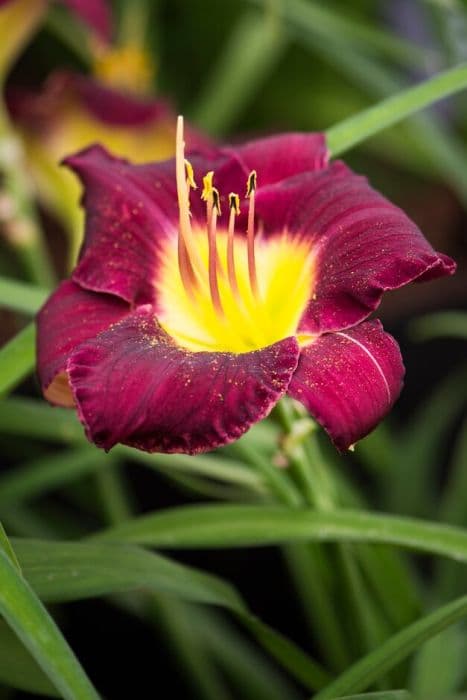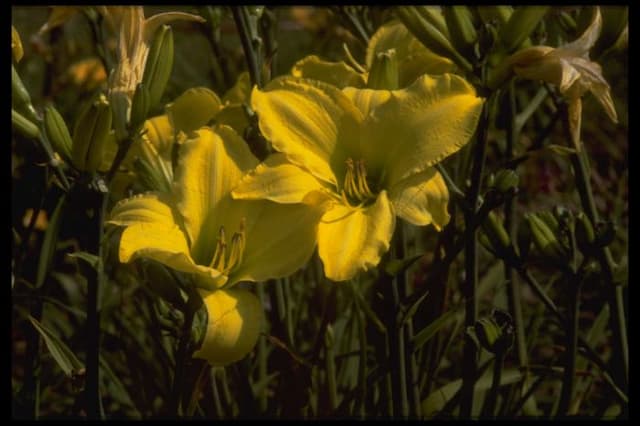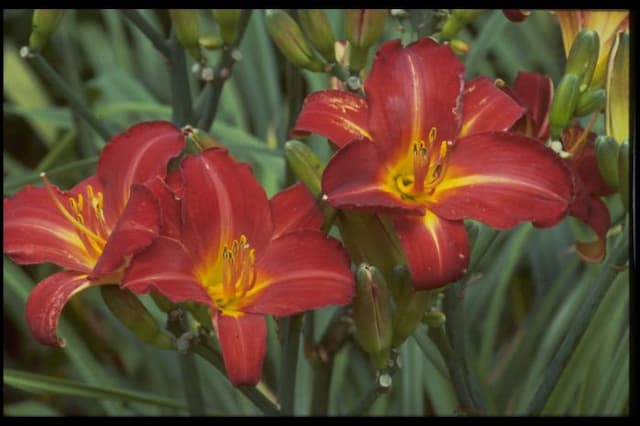Daylily Hemerocallis 'My Reggae Tiger'

ABOUT
'My Reggae Tiger' is a type of daylily known for its striking flowers, which are the plant's most remarkable feature. The blossoms showcase a vibrant color palette, commonly displaying a fiery blend of red, orange, and yellow hues that intertwine in a pattern reminiscent of a tiger's coat, hence the name 'Reggae Tiger'. Each individual flower comprises six petal-like segments called tepals. These tepals may have a smooth, wavy, or slightly ruffled edge, contributing to the flower's overall eye-catching aesthetic. The flowers bloom atop tall, sturdy stalks called scapes that emerge from a lush clump of strap-like foliage. The leaves are typically bright green, long, and arching, forming a fountain-like appearance that serves as a verdant backdrop for the showier blooms. The foliage's texture provides a pleasing contrast to the silky quality of the flowers, which only last for a day before being replaced by fresh blossoms during the blooming season. 'My Reggae Tiger' daylily's form is generally characterized by symmetry and an orderly arrangement of both leaves and flower stalks, with the blooms opening in succession over a period of time, providing a prolonged display of color in the garden. This daylily is appreciated not only for its beautiful appearance but also for its hardiness and ability to adapt to a variety of garden conditions.
About this plant
 Names
NamesFamily
Hemerocallidaceae
Synonyms
Daylily
Common names
Hemerocallis 'My Reggae Tiger'
 Toxicity
ToxicityTo humans
The Daylily 'My Reggae Tiger' is generally not considered toxic to humans. In fact, some parts of daylilies are edible and are sometimes used in culinary dishes in certain cultures. However, individuals with certain allergies or sensitivities may experience adverse reactions. It is always advisable to exercise caution and confirm the edibility of specific cultivars before consumption.
To pets
The Daylily 'My Reggae Tiger' can be toxic to pets, especially to cats. If ingested by a cat, it could lead to symptoms of poisoning that may include vomiting, lethargy, kidney failure, or other gastrointestinal distress. Kidney failure can be very serious and potentially fatal. It's crucial to prevent cats from accessing these plants and to seek veterinary care immediately if ingestion is suspected.
 Characteristics
CharacteristicsLife cycle
Perennials
Foliage type
Deciduous
Color of leaves
Green
Flower color
Mixed
Height
2 feet (60 cm)
Spread
1-2 feet (30-60 cm)
Plant type
Herb
Hardiness zones
3-9
Native area
Asia
Benefits
 General Benefits
General Benefits- Ornamental Value: Hemerocallis 'My Reggae Tiger', also known as Daylily, has vibrant and showy flowers that add visual appeal to gardens and landscapes.
- Drought Tolerance: Daylilies are known for their ability to withstand dry conditions, making them suitable for xeriscaping and low-water gardens.
- Low Maintenance: Daylilies are relatively easy to care for, requiring minimal upkeep once established, which makes them ideal for gardeners of all skill levels.
- Pest Resistance: Daylilies are resistant to many pests and diseases, reducing the need for chemical treatments and promoting a healthier garden environment.
- Adaptability: Daylilies can thrive in a wide range of soil types and environmental conditions, making them versatile additions to many garden settings.
- Long Blooming: Daylilies have a long flowering period, often blooming for several weeks, which ensures a continuous display of color throughout the growing season.
- Attracts Pollinators: The flowers of Daylilies attract butterflies, bees, and other pollinators, contributing to the health of the overall ecosystem.
- Erosion Control: The dense foliage and root systems of Daylilies help stabilize soil and prevent erosion, especially on slopes and in areas prone to soil degradation.
- Edible Parts: Certain parts of Daylilies are edible and can be used in culinary applications, although this is generally not the primary reason for their cultivation.
- Propagation Ease: Daylilies can be easily propagated by division, allowing gardeners to expand their plantings or share with friends without significant effort.
 Medical Properties
Medical PropertiesThis plant is not used for medical purposes.
 Air-purifying Qualities
Air-purifying QualitiesThis plant is not specifically known for air purifying qualities.
 Other Uses
Other Uses- Edible Flowers: Daylily blooms are edible and have a sweet and slightly vegetal flavor, making them a colorful addition to salads or as an edible garnish.
- Natural Dye: The petals of daylilies can be used to create a natural dye for fabrics, yielding shades of yellow, orange, or green depending on the mordant used.
- Companion Planting: Daylilies can be planted next to vegetables to deter certain pests or attract beneficial insects, improving the overall health and yield of the vegetable garden.
- Crafts: Dried daylily flowers can be used in potpourri mixes or to create floral arrangements and wreaths for home decoration.
- Garden Border: Daylilies, with their dense foliage, can serve as an effective living border to outline garden beds or pathways.
- Erosion Control: The robust root system of daylilies makes them good candidates for planting in areas prone to erosion, helping to stabilize the soil.
- Pond and Water Features: Daylilies can be planted around ponds or water features for aesthetic purposes, where they can also help to filter and clean the water.
- Wildlife Habitat: Daylilies provide shelter and breeding spots for beneficial insects, and their flowers can attract pollinators like bees and butterflies.
- Photography: The vibrant colors and unique patterns of daylilies make them great subjects for garden photography and botanical illustration.
- Culinary Experiments: The tubers of daylilies can sometimes be cooked and eaten like a root vegetable, offering a unique ingredient for adventurous cooks.
Interesting Facts
 Feng Shui
Feng ShuiThe Daylily is not used in Feng Shui practice.
 Zodiac Sign Compitability
Zodiac Sign CompitabilityThe Daylily is not used in astrology practice.
 Plant Symbolism
Plant Symbolism- Daylily (Hemerocallis 'My Reggae Tiger'): The daylily is often associated with motherhood and fertility due to its ability to produce numerous offspring (buds). The name 'Hemerocallis' comes from the Greek words for "beauty" and "day," hinting at the flower's ephemeral beauty as most daylily blooms last for just a day.
- Transience: The individual blooms of a daylily, which each last only for one day, remind us of the transient nature of life, urging us to cherish every moment.
- Renewal: As daylilies have new blooms each day, they are a symbol of renewal and the continuous cycle of life, representing hope and a new beginning every day.
- Forgiveness: In the language of flowers, a daylily can symbolize a desire for forgiveness or an apology, perhaps because its beauty is fleeting, implying a sense of urgency and humility.
 Water
WaterDaylilies like 'My Reggae Tiger' should be watered deeply once a week, depending on weather conditions and soil type. To water daylilies, ensure that the soil is moistened to a depth of about 8 to 10 inches. During hot, dry periods, you may need to increase watering frequency to twice a week, providing about 1 to 1.5 gallons of water per plant for each watering session. It is important to avoid overhead watering to prevent leaf diseases; instead, use a soaker hose or drip irrigation at the base of the plant. Ensure good drainage to prevent waterlogging, as daylilies do not like to stay in wet soil for extended periods.
 Light
LightDaylilies, such as 'My Reggae Tiger,' thrive in full sun to partial shade conditions. The best spot for planting them is in a location that receives at least six hours of direct sunlight per day. They can tolerate light afternoon shade, especially in very hot climates, but too much shade can reduce the number of blooms.
 Temperature
TemperatureDaylilies like 'My Reggae Tiger' can tolerate a wide range of temperatures but perform best when daytime temperatures range between 60°F and 90°F. They can survive minimum winter temperatures down to -20°F, making them suitable for gardens in USDA hardiness zones 3 through 9. To ensure vigorous growth and flower production, maintain temperatures within their ideal range during the growing season.
 Pruning
PruningPruning daylilies like 'My Reggae Tiger' mainly involves removing spent flowers and flower stalks to encourage reblooming and to maintain a tidy appearance. After the bloom period, cut back the foliage if it becomes brown or unattractive. Divide the clumps every three to five years to rejuvenate growth and increase blooming. The best time for pruning or division is immediately after flowering or in early spring.
 Cleaning
CleaningAs needed
 Soil
SoilDaylilies thrive in well-drained soil with a mix of two parts loam, one part peat moss or compost, and one part sand for aeration. The ideal soil pH for a Daylily should be slightly acidic to neutral, between 6.0 and 7.0.
 Repotting
RepottingDaylilies, such as 'My Reggae Tiger,' do not require frequent repotting and are generally repotted every three to four years or when the clump becomes overcrowded.
 Humidity & Misting
Humidity & MistingDaylilies are adaptable to a range of humidity levels and do best with average outdoor humidity, without any special humidity requirements.
 Suitable locations
Suitable locationsIndoor
Provide bright, indirect light and ensure good air circulation.
Outdoor
Plant in full sun to partial shade with well-draining soil.
Hardiness zone
3-9 USDA
 Life cycle
Life cycleThe life cycle of Hemerocallis 'My Reggae Tiger', commonly known as Daylily, begins with seed germination, where the plant emerges as a seedling and starts to develop roots and foliage. As it matures into vegetative growth, the daylily forms a clump of strap-like leaves and strengthens its root system. Once it reaches maturity, the daylily produces flowering stalks called scapes, each bearing several buds that bloom into vibrant flowers, typically lasting just one day each during the blooming season. After pollination, which can occur by insects or manual intervention, the flowers develop into seed pods if conditions permit. The plant may also propagate through division, where the clumps are split and replanted to produce new growth. Daylilies are perennial, so after the blooming season and seed set, the foliage dies back, and the plant enters a period of dormancy in colder climates, only to regrow from the root system with the arrival of warmer weather in subsequent seasons.
 Propogation
PropogationPropogation time
Late Summer to Early Fall
The Hemerocallis 'My Reggae Tiger', commonly known as a type of Daylily, is most commonly propagated through division. The best time to propagate this perennial plant is in the early spring or late summer, after flowering has finished. Division involves separating the clump of the plant into smaller sections by gently pulling or cutting apart the clumps. Each section should have at least one fan of leaves and a portion of the root system. After division, the plant sections should be replanted at the same soil depth from which they were taken and watered thoroughly. This method encourages rejuvenation and increases the number of plants for the garden or to share with fellow gardeners.









